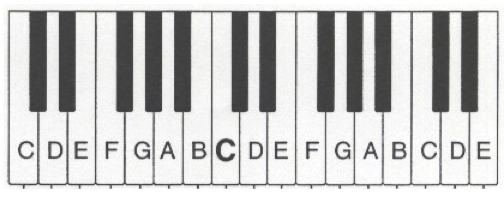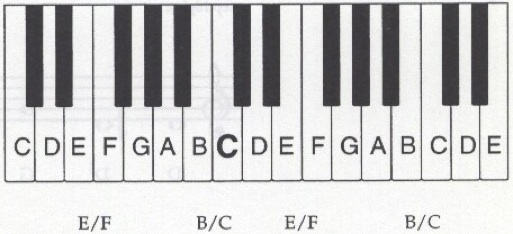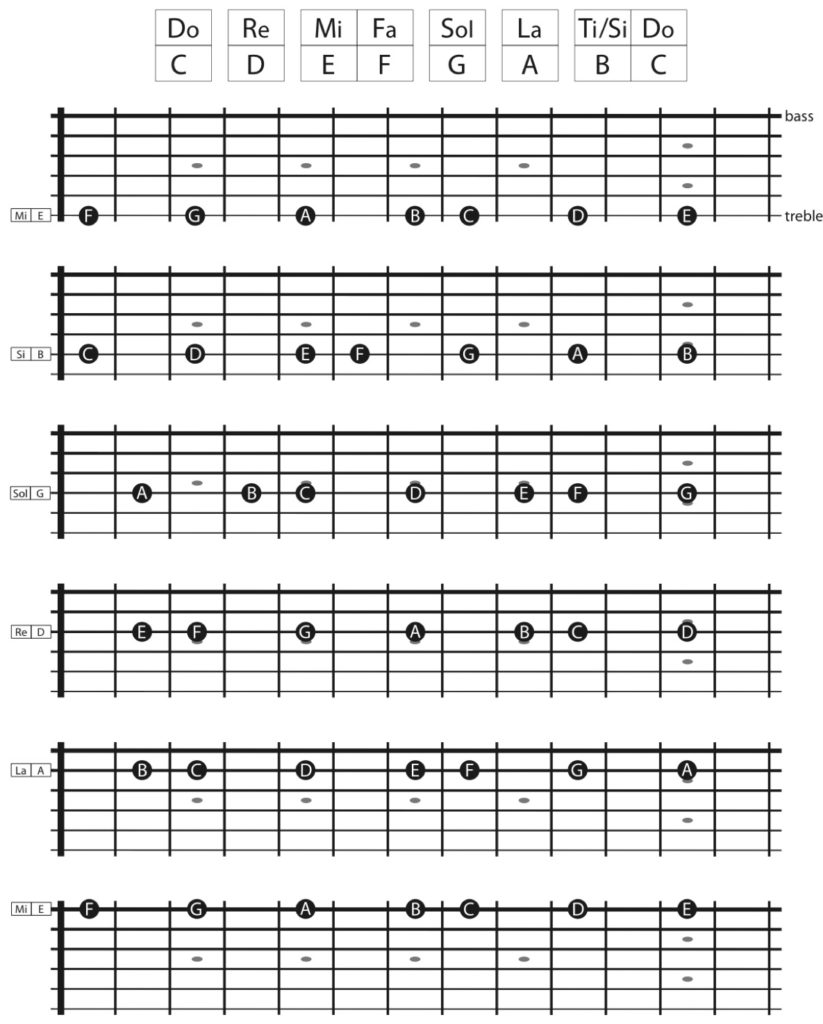The Major Scale
A scale is a series of different sounds/notes, which are located at certain distances from one another.
These distances between sounds are called “intervals” and are expressed in “steps”.
An “interval” is a distance between 2 sounds, a certain number of steps (or frets) apart.
The smallest distance/interval between 2 sounds in music-theory is called a “HALF STEP”.
This corresponds to 2 adjacent keys on a piano or 2 adjacent frets on a guitar neck.

A “whole step” consists of 2 half steps: you skip a fret on the guitar (2 frets distance).
Of all the 2048 possible scales that exist in music, which you can read more about here:
The 2048 Possible Note Combinations
Only 2048 Possible Scales in Music
… the “major scale” is one of the most widely used scales in the world.
Is the most used scale in all of Europe, all of the North, Middle and Latin-American countries, all of Africa, and also part of the far east. (Japan, China, etc.)
Because it is the most widely used scale in the world, most every music theory book written in the Western World uses the major scale as its starting point from where all theory is explained from.
There is only 1 exception to this that I know of: the groundbreaking book “Lydian Chromatic Concept of Tonal Organization” by George Russell, which explains all Western music theory from a Lydian scale perspective.
This book influenced John Coltrane, Miles Davis, and many other jazz greats.
You can check the book out here:
Apart from George Russell’s book, all other music theory books use the major scale as the starting point to explain all music theory.
The sound of the major scale is the result of the intervallic structure of that scale and defines the color, vibe, and atmosphere of our music.
Our music sounds the way it sounds, because of the structure of the scale that we use to write our music with.
Middle Eastern music, for example, sounds totally different from music in the Western world, simply because Middle Eastern scales consist of different whole and half step configurations.
The scale used in Middle Eastern music has more half-step intervals, and these half steps are in different locations in the scale than they are in the scales we use in the western world. The result is a totally different musical sound, atmosphere, and texture.
So speaking of scale structures: let’s have a look at what a major scale is.
Structure of The Major Scale.
I oftentimes have students who have been playing many years, and who blank out on me when I ask them to explain what a major scale is.
I often get the remark then: “I know what it is, but is kinda hard to explain”.
I always like to think of that quote, which supposedly Einstein uttered along the lines of “If one cannot explain things in a way that a 6-year old immediately understand what one is talking about, then one doesn’t really understand it her/himself yet.”
That is always the best test to verify how well you really know something: try to teach it to someone.
When you get stuck in your explanation, or you’re unable to answer every possible question the student asks you about the topic, then you need to go back to the drawing board.
Do you need to be able to explain something to be able to play it?
No, you don’t!
But if you CAN, then you automatically are more in control with a much deeper understanding of what you’re doing or what’s going on.
There are 2 ways to explain or define the major scale.
- By the intervallic distances from note to note.
whole step / whole step / half step / whole step / whole step / whole step / half step

This is how it looks like on a piano keyboard:

Each step from 1 key to the adjacent key on the piano is called a “half step” in music theory. The “half step” is the smallest interval we have in our music. The adjacent keys on a piano correspond to adjacent frets on a guitar. The spaces in between the notes on the above guitar fretboard correspond to the black keys on a piano.
Notice how there is no black key between E-F or between B-C on the piano keyboard, and correspondingly, there is also no fret space in between those notes on the guitar neck.
Another way to define the major scale is by…
- The Half Step Locations
The half steps are in between 3-4 and 7-8
In other words: in a major scale, the 3rd and the 4th note are on adjacent frets/keys, and the 7th and the 8th note are on adjacent frets/keys.When you start a major scale from note C, you happen to play the notes:
C D E F G A B, which is all the white keys on a piano.
The above guitar neck picture shows that the half steps in a C major scale are located from E to F, and from B to C.
Indeed, E is the 3rd note and F is the 4th note in a C major scale. B is the 7th note and C is the 8th note.The picture below shows the notes E-F and B-C without the other scale notes on the 2nd string.

The following piano keyboard shows how E-F and B-C are also adjacent keys on a keyboard.
2 adjacent frets on a guitar neck = 2 adjacent keys on a keyboard.
Now you know that a major scale is:
2 whole steps half, 3 whole steps half, with the half steps between 3-4 and 7-8
Naturals, Sharps (#’s) and Flats (b’s)
When you start that structure on note C, you are playing a “C major scale”.
The C major scale is the only major scale that consists of white keys only (meaning: that does not have any sharps or flats).
These notes, are named using 7 letters from A to G, and are called “naturals”
The 7 naturals are.
- the 7 white keys of the piano, or in other words
- alphabet note names, or in other words
- note names that don’t have “sharp” (#) or “flat” (b) in the note name.
There are 5 black keys in between the white keys. Those are named # or b, as in C#, Eb, Ab, etc.
The note a half step higher than a natural (i.e. “A”), is called # (i.e. A#)
The note a half step lower than a natural (i.e. “A”), is called b (i.e. Ab)
Hence there are 2 note names for the 5 black keys.
- The note between C and D is called C# or Db
- The note between D and E is called D# or Eb
- The note between F and G is called F# or Gb
- The note between G and A is called G# or Ab
- The note between A and B is called A# or Bb
(Knowing when to use which name, is something we’ll cover in a future blog)
Here’s the C major scale mapped out on every string:

Have fun soloing over a C major song or backing track, 1 string at a time.
What Makes this “THE” Major Scale?
That is a good question because there are tons of major scales.
Here’s what makes a major scale a major scale: the distance from the first to the 3rd note is 2 whole steps .
That interval is called a “major 3rd”.
All scales that have a major 3rd distance between the first and 3rd note of the scale, are all major scales.
Conversely: when the distance from the first note to the 3rd note is only a step and a half (3 frets, also called “a minor 3rd interval”) then that scale is a minor scale.
So if there are tons of major scales, why is this one called “THE” major scale.
Answer: this is the ONLY major scale that doesn’t have any minor intervals.
Using the C major scale as an example:
- C to D = a major 2nd interval (also called 2, as opposed to b2, which would be a “minor 2nd, i.e. C to Db))
- C to E = a major 3rd interval (also called 3, as opposed to b3, which would be a “minor 3rd, i.e. C to Eb)
- C to F = a perfect 4th (also called 4)
- C to G = a perfect 5th (also called 5)
- C to A = a major 6th (also called 6, as opposed to b6, which would be a “minor 6th, i.e. C to Ab)
- C to B = a major 7th (also called 7, as opposed to b7, which would be a “minor 7th interval, i.e. C to Eb)
- C to C = a perfect octave. (also called 8)
Since major intervals and perfect intervals are labeled with numbers, that means that the intervallic (number) formula for the major scale is:
1 2 3 4 5 6 7
THAT is why the major scale is useful as the starting point to explain all music theory from.
All of the other 2047 scales that exist in music, can be explained as a deviation (adding #’s or b’s) of any of the 7 numbers that make up the major scale structure.
For example:
- A minor scale is 1 2 b3 4 5 b6 b7 (3 notes different from a major scale structure, the 3rd, 6th and 7th note are a half step down)
- A Lydian scale is 1 2 3 #4 5 6 7 (1 note different from a major scale: the 4th note is raised up a half step)
Shoot me an email at vreny@zotzinmusic.com if you have any questions, or if you would like me to email you backing tracks to jam with the major scale.
In next week’s blog, we’ll cover the in-position fingerings.
You’re on your way to becoming a better guitar player.
Have fun! 🙂
Conclusion
Hit me up anytime at vreny@zotzinmusic.com if you have any questions, or if you would like to book a lesson.
These free lessons are cool, but you will never experience the progress, joy, and results that my students experience in lessons when you’re learning by yourself from blogs and videos.
That is why people take lessons: way better results and progress, much more complete information, exposed to way more creative ideas than you can get from a blog or YouTube video.
There is only so much that self-study can accomplish.
If you want to see amazing results and progress in your guitar playing, buy your first lesson here and get started ASAP.
You’ll impress your friends and loved ones in no time with your guitar playing!
Consider donating any small amount to help me keep this blog going.
Thank you for your support!


